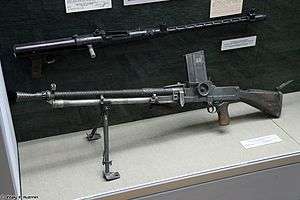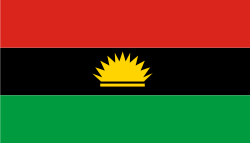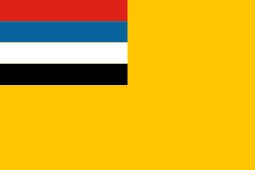ZB vz. 26
| Vz. 26 | |
|---|---|
 | |
| Type | Light machine gun |
| Place of origin | Czechoslovakia |
| Service history | |
| In service | 1926–Present (Upgraded versions in the Paraguayan Army) |
| Used by | See Users |
| Wars |
Second Sino-Japanese War Chaco War Spanish Civil War World War II Korean War Chinese Civil War Indochina War Biafran war Yugoslav Wars[1] |
| Production history | |
| Designer | Václav Holek |
| Designed | 1924 |
| Manufacturer | Zbrojovka Brno, Military Technical Institute Kragujevac[2] |
| Produced | 1924–1945 |
| Variants | See Variants |
| Specifications | |
| Weight | 10.5 kg (23.15 lb) |
| Length | 1,150 mm (45.3 in) |
| Barrel length | 672 mm (26.5 in) |
|
| |
| Cartridge | 7.92×57mm IS |
| Action | Gas-operated, tilting breechblock |
| Rate of fire | 500 rounds/min |
| Muzzle velocity | 744 m/s (2,441 ft/s) |
| Effective firing range | 1,000 m (1,100 yd) |
| Feed system | 20-round detachable box magazine |
| Sights | Front blade, rear leaf sight |
The ZB vz. 26 was a Czechoslovak light machine gun developed in the 1920s, which went on to enter service with several countries. It saw its major use during World War II, and spawned the related ZB vz. 27, vz. 30, and vz. 33. The ZB vz. 26 influenced many other light machine gun designs including the Bren light machine gun and the Type 96 Light Machine Gun. The ZB-26 is famous for its reliability, simple components, quick-change barrel and ease of manufacturing. This light machine gun in the Czechoslovak army was marked as the LK vz. 26 ("LK" means "lehký kulomet", light machine gun; "vz." stands for "vzor", Model in Czech). ZB vz. 26 is incorrect marking because "ZB-26" is a factory designation (Československá zbrojovka v Brně), while "vzor 26" or "vz. 26" is an army designation.
Development
In around 1921 the military of the young Czechoslovakian state embarked on a quest for a light machine gun of their own. Early trials included foreign designs such as Berthier, M1918 Browning automatic rifle, Darne machine gun, Hotchkiss M1914 machine gun, Madsen machine gun, St. Étienne Mle 1907, and several domestic designs. Of these, the most important was the Praha II, a lightweight, belt-fed weapon built at Česka Zbrojovka (CZ) Praha (Czech Arms factory in Prague). Development of the ZB-26 began in 1923 after the Czechoslovak Brno arms factory was built. Since CZ-Praha was a relatively small factory with limited industrial capabilities, it was decided to transfer the production of the new automatic weapon to the more advanced Zbrojovka Brno, or ZB in short. This transfer resulted in a long series of court trials over royalties, between the owners of the design (CZ-Praha) and the manufacturer (ZB). Designer Václav Holek was charged by the Czechoslovak army with producing a new light machine gun. He was assisted by his brother Emmanuel, as well as two expatriate Poles: Marek and Podrabsky. Holek was a genius as a firearms designer; he quickly began work on the prototype on the Praha II and within a year the quartet had created an automatic light machine gun that was later known as the ZB. Before long, the Holek brothers abandoned the belt feed in favor of a top-feeding box magazine and the resulting weapon, known as the Praha I-23, was selected. Despite the past legal troubles, manufacture of the new weapon had commenced at the ZB factory by late 1926, and it became the standard light machine gun of the Czechoslovak Army by 1928.
Design
The ZB-26 was a gas-operated, air-cooled, selectively fired, machine gun. It has a finned, quick-detachable barrel and fires from an open bolt. Its action is powered by a long-stroke gas piston, located below the barrel. The gas block is mounted at the muzzle end of the barrel and also serves as the front sight base. The action is locked by tipping the rear of the bolt (breechblock) upwards, and into a locking recess in the receiver. The return spring is located in the butt of the weapon, and is connected to the bolt carrier/gas piston via a long rod; additionally, there is a short spring buffer located around the return spring at the juncture of the receiver and butt, which softensthe impact of the bolt group at the end of its rearward stroke.
Its charging handle is located at the right side of receiver and does not reciprocate when the gun is fired. The ammunition feed is from top-mounted box magazines made from sheet steel and hold only 20 rounds in a two-row configuration. The magazine housing has a sliding dust cover which is slid forward to load the gun. Spent cartridges are ejected downwards. The ejection port is normally closed with its own dust cover which opens automatically once the trigger is pressed. The trigger unit permits both single shots and automatic fire, selectable through a safety/fire mode selector lever situated at the left side of the pistol grip. The gun fires from an open bolt and the spring-loaded firing pin is operated by a projection on the bolt carrier, once the bolt is fully in battery and locked. Because of the overhead magazine, the sight line is offset to the left, and the front sight is mounted on a base which protrudes upward and to the left from the gas block.
The rear sight is attached to the left side of receiver, and has a range adjustment mechanism controlled by a knurled-rotating knob. Standard furniture consists of an integral folding bipod, which is attached to the gas cylinder tube, and a wooden butt with a spring-buffered buttplate and a folding shoulder rest plate. Although the ZB-26 was intended for the light machine gun role, it was also offered with a sustained-fire tripod, and provided with a sufficient supply of full magazines and spare barrels it could serve (to some extent) as a medium machine gun. The same tripod was also adaptable for the anti-aircraft role.
Deployment and service
The ZB-26 saw service with the Czechoslovak infantry, as well as being the primary or secondary armament on many later model Škoda armored vehicles. It is believed that the ZB factory turned more than 120,000 ZB-26 guns between 1926 and 1939 in a variety of calibers (the most popular being its original 7.92×57mm Mauser). It was exported to twenty-four European, South American and Asian countries, both in its original form and in the slightly improved ZB-30 version. Large batches of ZB light machine guns went to Bolivia, Bulgaria, China, Romania, Turkey and Yugoslavia. Exports continued up until 1939, when Nazi Germany under Adolf Hitler took over Czechoslovakia.

The Wehrmacht soon adopted the ZB-26 after the occupation of Czechoslovakia, renaming it the MG 26(t); it was used in the same role as the MG 34, as a light machine gun. In the opening phases of World War II, the ZB-26 in 7.92mm Mauser caliber was used in large numbers by elements of the German Waffen-SS, who at first did not have full access to standard Wehrmacht supply channels. In its most famous incarnation, the ZB-26 was modified by ZB and British technicians, entering service as the famous Bren gun. Many more countries imported or produced the design under license, including China, Yugoslavia, and Lithuania. Chinese Nationalist forces used the ZB-26 chambered for the 8×57mm Mauser round in their struggle with Communist Chinese and later Imperial Japanese forces. Likewise, the Chinese Red Army (as with any other captured weapon) turned the Nationalists' ZB-26 machine guns against them and the Japanese. According to Brno, from 1927 to 1939, a total of 30,249 ZB-26 were exported to China. During this time due to high demand, Chinese small-arms factories—state-owned as well as those controlled by various warlords—were producing the ZB-26. During the Korean War, Chinese Communist forces employed the ZB-26 against UN forces, and PVA ZB gunners developed a well-deserved reputation for long-range marksmanship. During the First Indochina War with French and later South Vietnamese forces, the ZB-26 was found in the hands of both North Vietnamese Army and Viet Minh guerrillas.
Variants
- ZB vz. 24: the weapon's predecessor.
- ZB vz. 27: later variant.
- ZB vz. 30: later variant.
- ZGB 30: final modifications to the vz. 30 for British trials.
- ZGB 33: in its final form was virtually identical to the British Bren light machine gun.
- ZB 39: commercial variant of the Bren, chambered in various different rounds and having different sights, among other minor changes.
More designations appear depending on the adopting army, though generally the gun retains its 'ZB 26' initials in one form or another.
Although the ZB-26 had few variants, some weapons were closely based on it:
- The Japanese Type 97 light machine gun was a license built copy of the ZB-26 and intended for use in Japanese tanks. It was not normally issued as an infantry light machine gun. Other than the cocking handle being moved from the right side of the receiver to the left it is essentially a duplicate of the Czech gun in operation.
- The Japanese Type 96 was similar in its layout but used a completely different operating system. It was unique in its locking system which did not resemble any other contemporary mechanisms. It did however use the top mounted magazine and a bipod mount.
- The Finnish Kk 62 light machine gun.
- The German MKb 42(h) assault rifle used a virtually identical, although inverted, bolt/bolt carrier system.
- The Spanish Fusil Automático Oviedo (F.A.O.).
- The British Bren light machine gun (Brno Enfield) and Light machine gun (LMG)
Users

.svg.png) Afghanistan
Afghanistan Bolivia
Bolivia Bulgaria
Bulgaria Biafra
Biafra People's Republic of China[3]
People's Republic of China[3] Republic of China
Republic of China Independent State of Croatia
Independent State of Croatia Czechoslovakia
Czechoslovakia Ecuador
Ecuador Finland
Finland.svg.png) Nazi Germany
Nazi Germany Indonesia
Indonesia Imperial State of Iran
Imperial State of Iran Israel
Israel.svg.png) Empire of Japan
Empire of Japan North Korea
North Korea Republic of Korea: Used during Second Sino-Japanese War by the Korean Liberation Army
Republic of Korea: Used during Second Sino-Japanese War by the Korean Liberation Army Lithuania Some 3100 machine guns vz. 26 (7,92 mm kulkosvaidis Brno 26 m.)
Lithuania Some 3100 machine guns vz. 26 (7,92 mm kulkosvaidis Brno 26 m.) Malaysia
Malaysia Manchukuo
Manchukuo Peru
Peru Romania
Romania Slovak Republic
Slovak Republic Soviet Union (partisans)
Soviet Union (partisans) Spain
Spain Sweden as the Kulsprutegevär m/39
Sweden as the Kulsprutegevär m/39 Turkey
Turkey North Vietnam[4]
North Vietnam[4] Yugoslavia
Yugoslavia
See also
References
- ↑ The Defense Of Bosnia. Studio "FLASH" Sarajevo. April 1999. Event occurs at 45:53. Retrieved 22 May 2015.
- ↑ http://www.zastava-arms.rs/sr/imagetext/1919-1941
- ↑ Jowett, Philip. The Chinese Army 1937-49: World War II and Civil War. Osprey Publishing. p. 44. ISBN 1-84176-904-5.
- ↑ Chris Bishop (1996). Vital Guide to Combat Guns and Infantry Weapons. p. 203. ISBN 1853105392.
External links
| Wikimedia Commons has media related to ZB 26. |